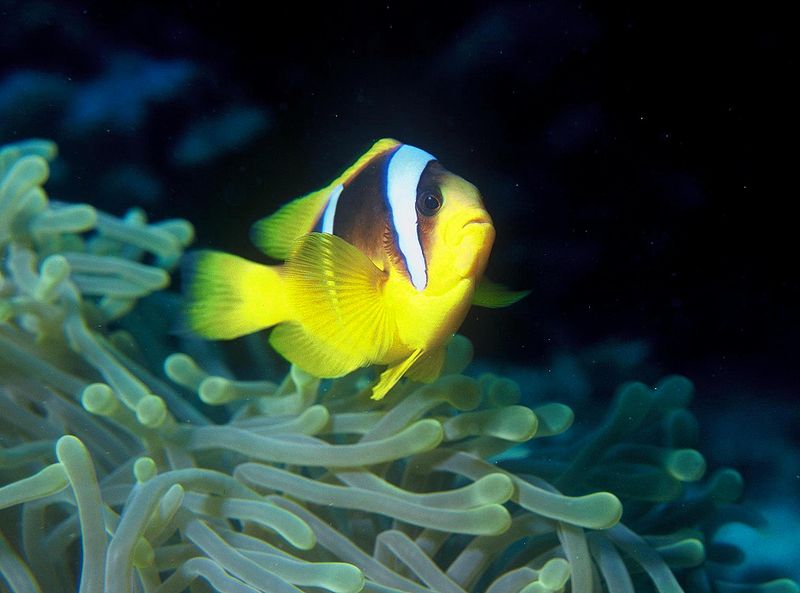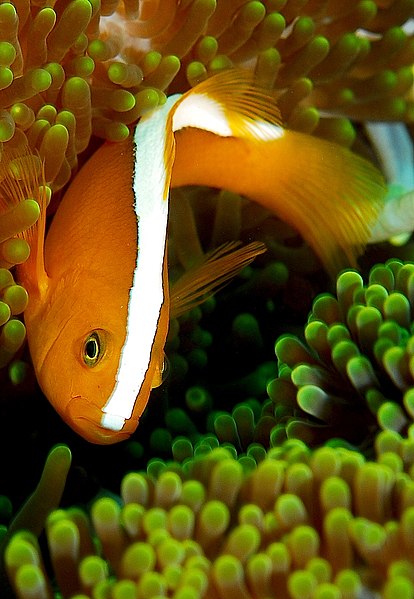Hello, Frank Indiviglio here. Please see Part I of this article for information on the natural history of the clownfishes and their close relatives, the damselfishes. Today we’ll take a look at the most popularly kept of the clownfishes, the beautifully-colored Percula clownfish, Amphiprion ocellaris.
Even before being skyrocketed to fame by the movie Finding Nemo, the Percula was an aquarium favorite, and one of the most widely-recognized marine fishes in the world. Its brilliant orange and white coloration and seemingly “comic” mode of swimming endears it to all.
Natural History
 Hailing from the Indo-Pacific region (western Pacific and eastern Indian Oceans, including the Great Barrier Reef), this clownfish reaches a length of 3.2 inches in captivity; wild specimens are reported to exceed 4 inches in length, but captive bred animals are generally smaller.
Hailing from the Indo-Pacific region (western Pacific and eastern Indian Oceans, including the Great Barrier Reef), this clownfish reaches a length of 3.2 inches in captivity; wild specimens are reported to exceed 4 inches in length, but captive bred animals are generally smaller.
Observations of free living Percula clowns indicate that they usually colonize magnificent sea anemones, Heteractis magnifica. I have not read any research indicating that the various clownfishes seek out host anemones based upon their ability to survive within a particular species (please see Part I), but such would certainly be interesting to investigate. Please note: Maldive Clownfishes are pictured here with a Magnificent Sea Anemone.
Clownfishes in the Aquarium
Like all clownfishes, the Percula is territorial and quite protective of the anemone in which it lives. Generally only one mated pair can be maintained in an aquarium, unless it is very large and well stocked with coral and other sight barriers.
Percula Clowns are omnivorous, and accept a wide variety of dry, frozen and live foods. A mix of vegetable-based and meaty items should be provided.
Fortunately, captive bred specimens are readily available. If considering a Percula Clownfish, please be sure to select a captive bred animal.
The Anemone-Clownfish Relationship
Percula clowns do fine in captivity without an anemone in which to live, but not so
in the wild….there, clownfishes deprived of an anemone’s protection are quickly consumed by predators. However, they are at their best when displayed with a living anemone, and when kept so will reveal a great many of their interesting interactions with these invertebrates (please see Part I of this article for further information).
The keeping of live sea anemones differs somewhat from fish-keeping. For further information, please see the following articles on our blog: Unusual Invertebrates for marine Aquariums and Anemone Movement: Common Aquarium Questions .
Further Reading
Please check out the book I’ve written on marine and fresh water aquariums: The Everything Aquarium Book.
You can learn about clownfish natural history here.
Please write in with your questions and comments.
Thanks, until next time,
Frank Indiviglio
 That Fish Blog – Aquarium Advice and Information
That Fish Blog – Aquarium Advice and Information

 few occur in the Atlantic and Eastern Pacific Oceans. They occupy a startling variety of habitats, with many species restricted to specific depths or specific areas of wave action. Several species can even enter brackish waters.
few occur in the Atlantic and Eastern Pacific Oceans. They occupy a startling variety of habitats, with many species restricted to specific depths or specific areas of wave action. Several species can even enter brackish waters. Anemone tentacles fire their sting-bearing cells (nematocysts) upon contact with any organism that they come in contact with. The tentacles are coated with mucus which inhibits them from stinging one another. It seems that the clownfish secretes mucus which mimics that covering the tentacles of the anemone. Therefore, the anemone simply does not recognize the clownfish as prey, or even as a distinct organism!
Anemone tentacles fire their sting-bearing cells (nematocysts) upon contact with any organism that they come in contact with. The tentacles are coated with mucus which inhibits them from stinging one another. It seems that the clownfish secretes mucus which mimics that covering the tentacles of the anemone. Therefore, the anemone simply does not recognize the clownfish as prey, or even as a distinct organism!